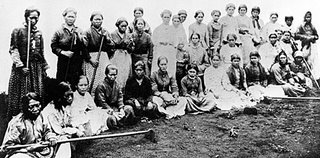Listen and Learn

Sugar field workers pose for a photo in Kilauea, Kauai in 1888. (Photo: Honolulu Advertiser Archives)
I'm feeling professorial today, so here are some audio history lessons on Hawaii, courtesy of "Crossing East," a great 8-hour public radio documentary series on the history of Asian America. Click on the links below to check out the segments that include Hawaii.
Program One: First Contacts
Kanaka Village: Fur pelts sold for as high as a 3000% percent profit in China in the 1700s. Many British and American companies, while fighting over the territory of North America, hired anyone they could find to trap and transport those furs, including many Hawaiians.
Program Three: Raising Cane
Hawaii was a self-contained society when Captain Cook made first contact. Then settlers and missionaries turned Hawaiians into workers and the islands into plantations. Crossing East weaves a unique cross-cultural American tale through music, descendant histories and sounds of Hawaii.
- Hard Labor: By 1850, the sugar industry exploded. Plantations needed cheap labor, fast. The first workers came from China. Then Japan, Korea, the Philippines. The laborers had hopes of making money quickly and returning home.
- Picture Brides: In 1900, the plantations were bachelor societies. 20 percent of workers were women. Some men married native Hawaiian women, but many Japanese, Okinawan, and Korean men asked their families to help arrange a marriage across the ocean.
- Strength & Resistance: Plantation owners exploited racial differences. They pitted workers against each other. Organized protest began along ethnic lines in the early 1900s. Workers needed higher wages to support their families and a new strategy to beat the plantation system.
- Plantation Life: Plantation workers lived in camps next to the sugar and pineapple fields. The plantation segregated them – there was Chinese camp, Filipino camp, Puerto Rican camp and so on. Conditions were often squalid until families took steps to improve their own lives.
- Pidgin English: “Talk Story” is a term used in Hawaii for people gathering together for conversation. On the plantations, people of different ethnicities had to find a way to communicate, so they created a common language to talk to each other.
There are also profiles of Asian American and Pacific Islander artists, actors, and musicians, including master slack key guitarist Ledward Kaapana.
RELATED POSTS:
>> Respecting Host Cultures While Filming
>> How Da Haoles Wen Stole Hawaii: The Film(s)
>> Hawaii Newbies, Read This
>> A Pictorial History of Hawaii
>> Hawaii vs. Hawaiian
>> Culture Clash








